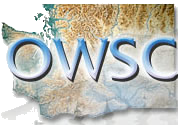On the “Great American Solar Eclipse”
While not a meteorological phenomenon, the historic “Great American Solar Eclipse” passed over the US on August 21, offering a view of at least a partial solar eclipse for the entire country, and deserves mention in this newsletter. Totality – when the moon completely covers the sun – was experienced in a 70-mile band from Oregon to South Carolina. Whether choosing to stay in WA to view the partial eclipse or traveling to other states to the south to experience totality, it can certainly be classified as the scientific buzz of the summer. Here we review the meteorological conditions in the Pacific Northwest during this exciting event.
After several weeks of postulating about potential cloud cover during the highly anticipated event, the weather was spectacular throughout the Pacific Northwest! The point in which the moon obscured most of the sun was around 10:20 am throughout the region, so there was valid concern that a marine layer could block the view west of the Cascade Mountains. Once the event became closer and forecasts were available, however, it looked like cloud cover would not be an issue. Figure 1a shows the column-integrated cloud water forecast made on August 16, 5 days before the event, with some clouds on the coast, but clear skies for the rest of the Northwest. An infrared satellite image at 10:15 am on August 21 shows that the clear skies verified, with clear conditions even on the coast (Figure 1b).


Figure 2 shows high-resolution temperature and solar radiation data for 3 sites in the Pacific Northwest. The John Day Climate Reference Network station in Oregon was in the path of totality and is east of the Cascade crest – 5-minute data are available. The Goldendale Agrimet station is in eastern WA, has 15-minute data available, and experienced 98% totality. Finally, the roof of the Atmospheric Sciences building on the University of Washington campus in Seattle has 1-minute data available and experienced 92% totality. We averaged the UW Roof data to 5-min data for ease of plotting.
A clear dip in temperatures is seen for all 3 sites beginning at about 9:50 am as the moon obscures part of the sun. The largest temperature drop of our 3 sites occurred unsurprisingly at John Day with a 4.8°F temperature signal during the eclipse (CRN analysis: http://www.atdd.noaa.gov/crneclipse/). The UW Roof and Goldendale saw a temperature drop of 4.0°F and 3.2°F, respectively. Goldendale has the lowest resolution data (15-minute) so we suspect that the temperature likely fell more than that during the event since it was at 98% totality. Overall, while notable and likely felt by eclipse watchers (ourselves at OWSC included!), these are modest temperature changes. Several analyses show that there were larger temperature drops in the eastern US during the event. One such analysis was done by Joe Zagrodnik of the UW Atmospheric Science Department and showed up to 10°F temperature drop for some National Weather Service stations with 5-minute data during totality in the eastern US. This is likely because the event occurred at a later – and warmer – part of the day in the central and eastern time zones.

The solar radiation for the day also shows a very clear marker of the event, and includes a rather quick return to “normal” values at the end of the event. Minimum solar radiation values of 30 W/m2, 26.9 W/m2, and 1 W/m2 were measured at the UW Roof, Goldendale, and John Day, respectively, during the peak of the event. These values represent a drop of about 500-600 W/m2 in solar radiation from where they would have been if the eclipse did not occur that day.
Many of our state climatologists partners run weather networks and were watching this event closely as well. If you found this piece interesting, then there are several websites dedicated to the eclipse observations worth checking out. Examples include observations from Kentucky (http://kymesonet.org/eclipse.html), Kansas (http://mesonet.k-state.edu/special/eclipse/), and North Carolina (http://climate.ncsu.edu/eclipse2017).
